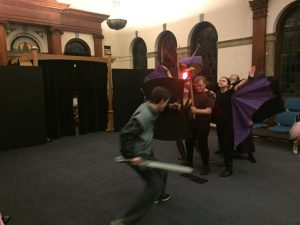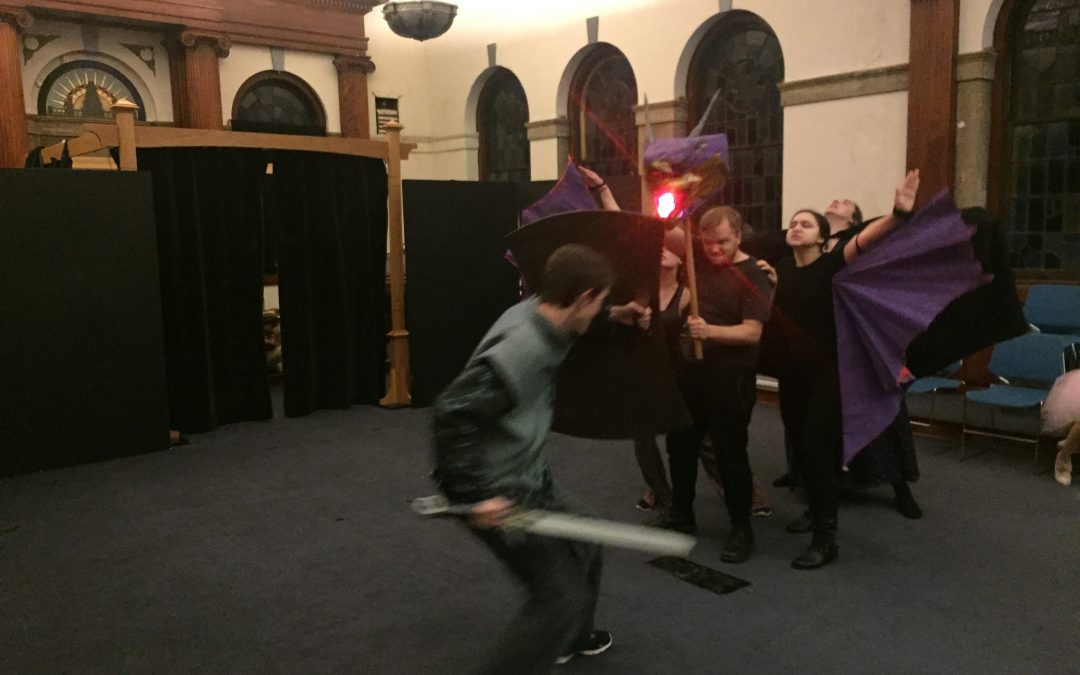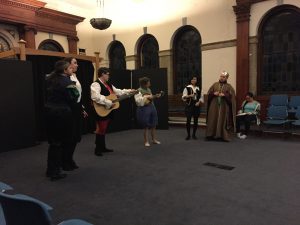The beast roars as fire shoots from its maw. It lunges, only to miss and get a swipe from a magic sword in return. The dragon, of course, is an elaborate puppet–one that takes four people to bring to life. This puppet forms one of the visual high points of Sleeping Beauty. The play is adapted from various versions of the story from Charles Perrault’s telling, to the Brothers Grimm’s, and even to Walt Disney’s. This new adaptation is the result of tireless thesis work from director Liz Bernardo.

Prince Phillip (Jacob Cornwell) faces off against the dragon, operated by Tiffany Waters, Tyler Dale, Emily Erblich and Clare Boyd. Photo by Kyle Smith.
“I really wanted to do William Shakespeare’s Star Wars, or something along those lines” Bernardo said. Bernardo’s thesis involves exploring how adaptations of works into iambic pentameter function on stage. “Unfortunately, Lucasfilm doesn’t give the rights for it. I wanted to, in turn, adapt a fairy tale, but most fairy tales involve a speaking animal, and I wanted to try to avoid a speaking animal onstage. Sleeping Beauty lent itself really well to that, because the strangest thing is the dragon, which is something that was used on the early modern stage.”
The script was initially drafted by Bernardo, but took shape over the course of rehearsal, with the cast members providing edits. The result is a final script that resembles the original in its plot structure, but has different language. The cast also collaborated to devise a dream sequence wherein they sing the Disney song “Once Upon a Dream,” which takes its melody from the waltz in Tchaikovsky’s ballet adaptation.
“Having the cast devise the dream sequence was the first thing we did, and it helped inform the rest of the process,” Bernardo said.
“Because of how Liz framed it, devising the dream sequence came about spontaneously,” said Clare Boyd, who plays the Evil Fairy. “The dragon was a lot of fun to devise. Josh Williams came in and worked the choreography with us. It’s been fun to devise how the dragon moves, how four of us can create this creature, and thinking about how I move when I’m not the dragon, and is it reptilian at all? We’ve talked about how that affects how I say my words.”
“I think the devising process is the most exciting thing about it,” said Becca Gossage, who plays Princess Aurora. “It’s just very fun and heartwarming. It’s these two people who’ve parents have decided that they’re going to get married for the union of two kingdoms, but they then find out that, actually, they’re really good friends; they are excited to be married, and they do love each other.”
The collation of sources was informed by what made for the best story.
“I’m not trying to scar kids, unlike Perrault, who probably was,” Bernardo said. This includes ending the story in the more traditional spot of the princess’ awakening, rather than the extended plot of the original story, where the prince and princess visit the prince’s ogress mother who tries to eat their children.
The play’s aesthetic adheres to a traditional medieval-Renaissance sensibility in line with the story’s origin as a fairy tale.
“Going traditional was probably the biggest challenge,” said costumer Tiffany Waters, who also plays the queen. “It was a little hard to find stuff that fit together. So we did a lot of rearranging, and a lot of color-coordinating, and we modernized the fairies a little bit, which I think helped us create the magical world as opposed to the royal world.”
Sleeping Beauty will premiere Sunday, Feb. 12 at 12:30 pm in Masonic Blue, while a Monday Feb. 13 performance at 8:00 pm will be shown on the Blackfriars stage. Both performances are free and open to the public, and families with children are encouraged to attend.



